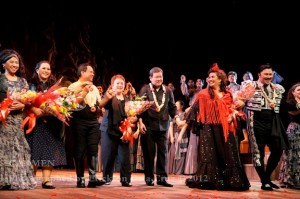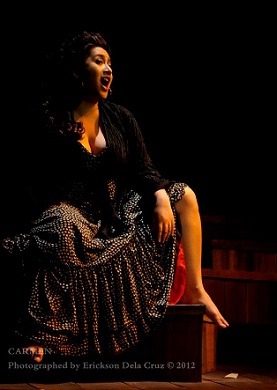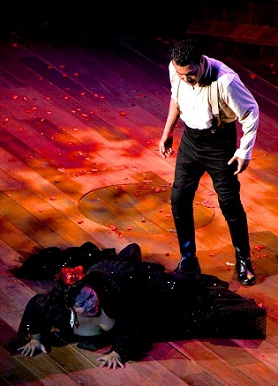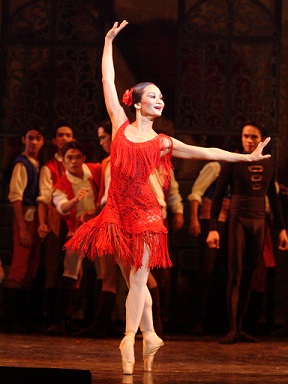By PABLO A. TARIMAN
 FRENCH composer Georges Bizet is Manila’s flavor of the month judging from the simultaneous staging of “Carmen” by the Lyric Opera of the Philippines and its ballet version by Ballet Manila.
FRENCH composer Georges Bizet is Manila’s flavor of the month judging from the simultaneous staging of “Carmen” by the Lyric Opera of the Philippines and its ballet version by Ballet Manila.
The weekend staging saw three Bizet heroines – Camille Lopez Molina, Ana Feleo, Lisa Macuja – ‘dying’ from the fatal knife of Don Jose played under varying intensity by Abdul Candao, Randy Gilongo and by danseur Rudy de Dios for the ballet version.
Hewing closely to Bizet’s realism, director Laurice Guillen had the Carmen of Feleo doing honest-to-goodness kissing scenes with the Bizet heroine even managing to unzip the pants of Don Jose in the seduction scene.
While the staging was stylized, Guillen got to the bottom of realism with the characters intensely driven, indeed, evocative of the opera’s atmosphere, theme and environment.
The superb directorial touch of Guillen was evident in the three nights of the Bizet opera complimented by a well-conceived choreography of Ina Feleo.
 Rehearsal master Peter Porticos told Guillen that the Being process of work the latter adapted was perfect for Carmen because it brought out the verismo of its music and libretto.
Rehearsal master Peter Porticos told Guillen that the Being process of work the latter adapted was perfect for Carmen because it brought out the verismo of its music and libretto.
At first look, the Carmen of Ana Feleo was young and irrepressible and her acting was a stand-out. The Don Jose of Randy Gilongo was a beleaguered one, at once tender and violent, but indeed full of longing in the Flower aria. The Micaela of Karina Gay Manlutac Balajadia-Liggayu was at once repressed and demure with a voice that didn’t soar as it should. Moreover, it is a lovely voice perfect for the part.
It was a class act on the last night of Carmen with subdued acting blending with excellent singing in the Carmen of Camille Lopez-Molina, the Don Jose of Abdul Candao and the genuinely moving Act III aria (“Je dis que rien ne m’épouvante”). of the Micaela of Margarita Gomez Giannelli.
Lopez-Molina’s “Habanera” was fresh and disarming and flirting had a touch of class in her Seguidilla. The tenor sound of Candao soared as the evening progressed and made his Flower Song haunting and inexplicably touching.
In the four successive performances beginning with the media preview, the Escamillo of baritone Noel Azcona singing the Toreador Song was solid and consistent, his exquisite ringing tone close to making his Act II aria the centerpiece of the opera. The Zuniga of Jun Jaranilla was at once commendable while the ensemble chorus under Gideon Bendicion and the children’s choir under Christopher Boreia brought out the choral magic of the Bizet score.
In the technical department, the set design of Gino Gonzales made the most of what the theater could offer, the lighting of Monino Duque perfectly enhanced the dramatic intensity of the opera especially in the last act when circles of blood-red designs swamped the stage in the tragic finale.
 The star of the opera is of course Bizet’s music and the Manila Symphony Orchestra under Arturo Molina made the score come alive with precise and pulsating beat. On top of that, the orchestra was one with the singers and that — of course — made a lot of difference.
The star of the opera is of course Bizet’s music and the Manila Symphony Orchestra under Arturo Molina made the score come alive with precise and pulsating beat. On top of that, the orchestra was one with the singers and that — of course — made a lot of difference.
True enough — in the words of John Glenn Gaerlan, president of Lyric Opera of the Philippines — the road to Carmen did not end in the three performances but actually opened new roads that brought the company and the performers to new heights.
The ballet version with additional music and arrangement by Rodion/Schedrin was tight and compact in the ballet version featuring the Carmen of Lisa Macuja, the Don Jose of Rudy de Dios, the Escamillo of Francis Cascano and the Micaela of Sofia Sangco Peralta.
The Carmen of Macuja had marked earthiness and commendable spunk. It was a total contrast from her Giselle and several notches the opposite of the playfulness of her Kitri in Don Quijote. Superb dancing and acting resulted in a highly appealing Carmen without the character’s tawdry elements.
But the big bonus in Ballet Manila’s Carmen was Rudy de Dios as Don Jose whose transformation from loyal soldier to deserter and forlorn suitor added more drama in the ballet version. His acting was real, his solo variations were jaw-dropping and yet he was also a gem of a partner in the series of pas de deux. Of the Don Jose during the weekend, De Dios was the most intense and the most brilliant actor and to think that he had no lines to deliver as his medium was dance.
 In the ballet version, the Habanera, Seguidilla, Flower aria and Toreador Song became dazzling solo variations and breath-taking pas de deux in this ballet favorite choreographed by Eric Cruz, the first artistic director of Ballet Manila.
In the ballet version, the Habanera, Seguidilla, Flower aria and Toreador Song became dazzling solo variations and breath-taking pas de deux in this ballet favorite choreographed by Eric Cruz, the first artistic director of Ballet Manila.
If Lyric Opera had a fantastic chorus, the corps de ballet of Ballet Manila lived up to the part as good dancing ensemble as they did in Giselle and Don Quixote.
And so it happened that three Filipina Carmen died during the weekend in the same Bizet masterpiece.
Macuja remarked, “Undeniably sexy Carmen is an adult ballet with a PG rating. My own kids loved the part when Mama gets stabbed. I have ‘died’ many times on stage in many different roles but Carmen is the best because she goes down laughing at the irony of it all.”